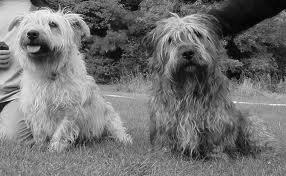
By Roslyn Blyn-LaDrew
You might recognize this dog better by its name in English, the Glen of Imaal terrier. And where’s the Glen of Imaal located anyway? Another alternate name for this dog will clarify – it’s also called the Wicklow terrier.
The Glen of Imaal is in the western Wicklow mountains, near the Lugnaquilla massif. In Irish, it is either Gleann Uí Mháil (glahn ee WAW-il) or Gleann Ó Máil. It is largely known today as a military firing range, but it is also a haunt for hikers, though they are advised to watch for posted firing schedules and not to pick up strange objects!
The Uí Máil (Ó Máil) part of the name comes from an ancient Leinster Irish dynasty, descended from Maine Mál, whose brother was Cathair Mór, a legendary high king.
The Irish name “Brocaire Uí Mháil” is a combination of the word for “terrier,” brocaire (lit. a badger-dog, from “broc,” a badger) and Uí Mháil. The word “glen” doesn’t actually appear in the Irish name. I suppose the presumption is if you have enough Gaeilge to know the breed’s name in Irish, you know that Imaal is a “gleann.” Just like most Philadelphians don’t order a “Philly cheese steak.” We just order “cheese steaks” and assume they will be Philly-style. After all, what other style is there?
Is it really the world’s rarest dog? It’s hard to say, because so many sources say different things. But its population in the United States is probably between 500 and 700, and there are about 35 in Ireland. Whatever the total, it’s fewer than the number of giant pandas, whose near-extinction status is well known.
One close contender for the rarest dog title is the New Guinea Singing Dog, which “trills” instead of barking, with an estimated population of 300.
How did this unique terrier come to be associated with such a remote area as the Glen of Imaal? The history dates back about 400 years to the time when Hessian mercenaries were used to help establish English control in Ireland. They brought their own low-slung hunting hounds with them and these were bred with local terriers, creating a new breed. Some of the Hessians remained in the area, as farmers, and they needed sturdy working dogs, so the breed continued.
The Glen of Imaal Terrier was only recently recognized by the American Kennel Club, in 2004. The Irish Kennel Club was the first to recognize it, in 1934. Founded 1922, with its first meeting held on January 20th of that year, the Irish Kennel Club followed closely after several other landmark events in Irish history, such as the January 7 passing of the Anglo-Irish Treaty in the Dáil and its signing, earlier, on December 6, 1921.
In terms of appearance, the Glens come in several colors, wheat, red and blue brindle. They typically weigh about 35 pounds, almost the same as their traditional quarry, the European badger, which weighs about 40 pounds. They’re very muscular, with a broad and slightly-domed skull. They have a “harsh” coat with a soft undercoat. They need to be “stripped” once or twice a year to remove shed fur. Their tail is “carried gaily.”
In temperament, they are agile and active and they work silently (they don’t bay when chasing prey). They are hard-working and known for “gameness.”
Aside from helping mankind by hunting vermin, the Glens were also used to turn the spits on which meat was roasting, by operating a treadmill. Their physique made them especially suitable to this work, with front legs bowed, turned-out forepaws, and strong hindquarters.
Today we might see this as exploitation, but back in the day, dogs worked for their living. I’ve seen the same apparatus used to power a paddle-washing machine in the U.S. Well, that is, when I saw it, it was part of a history demonstration, not contemporary!
Some illustrations of these devices can be seen at: http://blog.makezine.com/archive/2006/11/dog-power.html and the real McCoy can be seen at the Hadley Farm Museum in Massachusetts, and occasionally, at Amish auctions.
Gee, I would have thought the best dogs for turning a spit would have been the “Turnspitzen”! On that badly-punned note, Happy New Year, or, from the French perspective “Bone Année.” Italian Spinoni (gun-dogs) could chime in with “Bone Anno” and the Romanche canines with “Bone di Bone Onn.” To which the Irish-speaking dogs would no doubt reply, “Amh-bhliain faoi Bhuf-se!”
Note: the actual New Year’s greetings: French, “Bonne Année,” Italian, “Buon Anno,” and Romanche: “Bun di Bun Onn,” Irish: Athbhliain faoi Mhaise [AH-VLEE-in fwee WUSH-uh]. Irish dogs either say “Amh-Amh!” [awff-awff] or “Bhuf-Bhuf!” [wuf-wuf] when they bark!
For more information: contact the Glen of Imaal Terrier Club of America, founded in 1986, (www.glens.org) se!”
